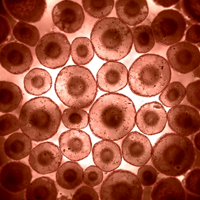

2010 GRANTS
- Project to generate transgenic mice that inhibit gene function to investigate whether certain structural genes involved in embryonic development of inner ear hair cells (responsible for hearing and balance) are also involved in formation of supporting cells. (Michael R. Deans, Ph.D., Johns Hopkins University School of Medicine)
- Development of a genetic mouse model to investigate whether the prestin protein gene has a different physiological function in mature outer hair cells than in developing outer hair cells. These cells are crucial for electromotility and amplification. The study is relevant to treating different causes of deafness. (Jie Fang, Ph.D., St. Jude Children�s Research Hospital, Memphis, TN)
- Genetic study of retinoic acid signaling perturbations during pregnancy that result in congenital inner ear defects. Retinoic acid (a biological derivative of Vitamin A) is important in inner ear development. The project is relevant to creating preventative therapeutic interventions. (Dorothy A. Frenz, Ph.D., New York Medical College)
- Study of how noise trauma impacts the function of the inner ear hair cell�s ribbon synapse, the first synapse in the auditory pathway where sounds are converted to electrical signals transmitted by the auditory nerve to the brain. The study is relevant to prevention of hearing loss from noise. (Juan D. Goutman, Ph.D., Instituto de Investigaciones en Ingenieria Genetica y Biologia Molecular [Buenos Aires, Argentina])
- Genetic investigation into using auditory stem cells to replace lost or damaged spiral ganglion neurons, focused on identifying axon guidance cues to hair cells and the auditory brain stem in the developing inner ear. Sensorineural hearing loss results from injury to spiral ganglion neurons. The work is relevant to therapies to treat auditory neuropathy. (Takako Kondo, Ph.D., Indiana University)
- Study of auditory abilities of mice with either genetically engineered decreased or enhanced medial olivocochlear (MOC) systems in the brain. The project investigates MOC function in hearing in normal and noisy situations, relevant to understanding hearing difficulties of children and older adults in noisy environments. (Amanda M. Lauer, Ph.D., Johns Hopkins University)
- Electrophysiological project in adults and young children examining how the brain processes speech in quiet and noise. The study is relevant to understanding normal speech-processing development and mechanisms underlying poor speech identification and discrimination. (Brett A. Martin, Ph.D., Graduate Center of the City University of New York)
- Developmental genetic study of how the sensory hair cells are innervated by afferent nerve fibers that send information from the inner ear to the brain, and by efferent nerve fibers that provide feedback from the brain to the inner ear. The focus is on the time-course of involvement of the nicotine-sensitive acetylcholine receptor. The investigation is relevant to treating hearing deficits caused by developmental malfunctions. (Isabelle Roux, Ph.D., Johns Hopkins University School of Medicine)
- Investigation to profile gene expression in the lateral cochlear wall in order to clarify the genetics of the Pendred Syndrome (DFNB4 � Enlarged Vestibular Aqueduct Disease Spectrum). Pendred Syndrome is the most common syndromic form of deafness, responsible for at least 10% of hereditary hearing loss in humans. The goal is prevention of progressive hearing loss in affected persons. (Richard J.H. Smith, M.D., University of Iowa�Year 1 of 2))
Learn More
Since 1988, the National Organization for Hearing Research Foundation has donated $10 million for 520 projects.
NOHR's mission incorporated into
Johns Hopkins University
Johns Hopkins University
 |
National Institute on Deafness and Other Communication Disorders www.nidcd.nih.gov |
 |
Association for Research in Otolaryngology www.aro.org |
 |
American Academy of Otolaryngology www.entnet.org |
 |
Write My Essay For Me by Academized.com academized.com |







